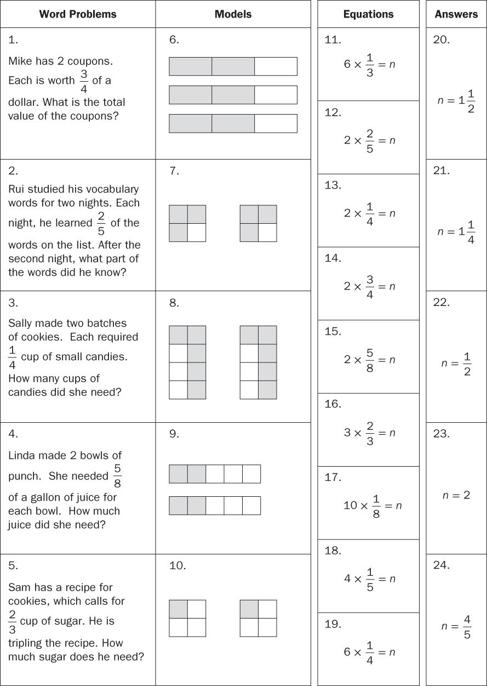Teaching the Common Core Math Standards With Hands-On Activities, Grades 3-5 (37 page)
Read Teaching the Common Core Math Standards With Hands-On Activities, Grades 3-5 Online
Authors: Judith A. Muschla,Gary Robert Muschla,Erin Muschla-Berry
Tags: #Education, #Teaching Methods & Materials, #Mathematics, #General


The product can be expressed as Using a unit fraction, the product can be expressed as
Using a unit fraction, the product can be expressed as
Activity: Complete the Rows
Working in groups, students will cut out cards and arrange them so that a word problem, its visual fraction model, the equation that represents the problem, and the answer are in a row.
Materials
Scissors; glue sticks; construction paper; reproducible, “Completion Cards,” for each group.
Procedure
1.
Hand out copies of the reproducible. Explain that it contains four columns of cards: Word Problems, Models, Equations, and Answers. There are a total of 24 cards.
2.
Explain that each word problem can be solved by using a visual fraction model and one or two different equations.
3.
Instruct students to cut out the cards. Starting with the first word problem, they should find the visual fraction model and equation, or equivalent equation, that can be used to solve the problem. Then they should find the answer to the problem.
4.
Explain that after finding the solution to a problem, students should glue the problem, model, equation or equations, and the answer in a row on their construction paper. They are to do this for all five problems. Note that no cards should be left over and no card can be used more than once.
Closure
Discuss students' work and the strategies they used to match problems, models, equations, and answers. Review any problems that proved to be difficult.
Answers
Cards are arranged in a row.
Row 1:
1, 7, 14, 19, 20
Row 2:
2, 9, 12, 18, 24
Row 3:
3, 10, 13, 22
Row 4:
4, 8, 15, 17, 21
Row 5:
5, 6, 11, 16, 23
Completion Cards
Number and Operations—Fractions: 4.NF.5
“Understand decimal notation for fractions, and compare decimal fractions.”
5. “Express a fraction with denominator 10 as an equivalent fraction with denominator 100, and use this technique to add two fractions with respective denominators 10 and 100.”
Background
To express a fraction with a denominator of 10 as an equivalent fraction with a denominator of 100, students should use the multiplication property of one, which states that any number multiplied by 1 equals the number.
1 can be expressed as Multiplying a fraction with a denominator of 10 by
Multiplying a fraction with a denominator of 10 by will result in an equivalent fraction with a denominator of 100. For example,
will result in an equivalent fraction with a denominator of 100. For example,
To add fractions with denominators of 10 and 100, students should write an equivalent fraction that has a denominator of 100 and then add the fractions. For example,
Activity: Fraction Bingo
Students will create a fraction bingo board by writing fractions from the Fraction Bank in each square on the board. You will present fraction problems, which students will solve. If the answer is on the student's board, the student will use a counter to cover the square that contains the answer. The first student to cover five squares in a row, column, or diagonal is the winner.
Materials
24 1-inch diameter (or smaller) counters; reproducible, “Fraction Bingo,” for each student. Optional: One copy of reproducible, “Fraction Problem Bank,” for the teacher.
Procedure
1.
Distribute copies of the Fraction Bingo board reproducible to your students.
2.
Explain that students are to randomly fill in each square on their board with a number from the Fraction Bank. They should not fill in the free space with a number. As they fill in a number, suggest that they cross out the number in the Fraction Bank so that they will not use the same number twice. Note that all numbers will be used.
3.
Explain the rules of the game. You will present problems in order, starting with number 1 on the “Fraction Problem Bank.” (
Note:
You may make a copy of the problem bank or simply read the problems from the page in your book.) Explain that after you present a problem, students are to solve the problem. Provide a few moments for them to work out the answer. They may use scratch paper. If they are correct, the answer will be on their board. Students who find the answer to the problem on their board should place a counter on the number. (
Note:
Having students use counters, instead of marking on the paper, allows you to use the same bingo boards for additional rounds of the game. Should you decide to play another round, present the problems in a different order.) Continue presenting problems until a student gets bingo by covering five squares in a row, column, or diagonal with counters.
4.
After a student announces she has bingo, check her answers to make sure that she is correct.

